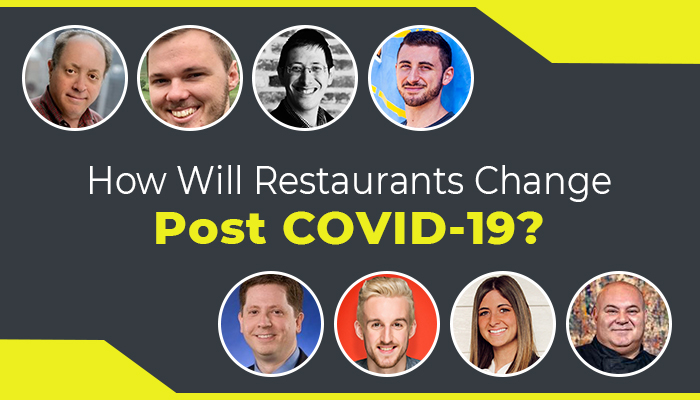
1000+
customers

50+ countries
across the world

Outsourcing leader
since 2008

Technology-driven
services

Stringent
quality processes
What Changes are Expected in the Restaurant Industry Post COVID-19?
Last updated: 10 Aug, 2023 By Puneet Sharma | 6 Minutes Read

Halted business operations due to COVID-19 have led to financial disruptions in the restaurant industry. Undoubtedly, the pandemic period will get over at some point in time in the coming future. However, restaurateurs need to understand that people’s mindsets will be changed in the post-pandemic period with respect to eating outside.
Let us figure out what strategies owners have in mind to ensure people start eating at their restaurants free of mind in the post-COVID-19 period!
1. People will be Still Reluctant Dining Out

I may have some data that would be worth a mention in your story. It shows the uphill struggle owners and managers face attracting diners back into restaurants.
A survey of 3,500 people done by Azurite Consulting found that 53% of Americans say they won’t be comfortable going to a sit-down restaurant for at least three months after social distancing ends. Also, 24% won’t dine out until a vaccine is available, and 15% will delay eating in a restaurant three months after a vaccine is accessible.
“The survey shows the hesitancy of people to go to restaurants even when restrictions are lifted,” said Eli Diamnet, director of Azurite Consulting. “Those surveyed felt they needed more time to assure safety and wellness before they return to a restaurant.”
According to the survey, 41% of families with two or more children will go to restaurants within one month of social distancing ending, while 35% of families with one child and 25% of people without children will wait for a vaccine, compared to 16% for families with two children.
Individuals in higher income brackets will be less cautious about returning to their favorite sit down restaurants with only 18% of people earning more than $150k waiting for a vaccine- compared to 26% of people earning less than $150k.
2. Multiple Precautionary Steps will be Taken

Restaurants will opt for the following changes once we enter the ‘new normal’ way of living:
- Contact tracing forms will have to be filled in upon entry to establishments.
- Restaurants will opt for cashless payments instead of the traditional coins and paper bills.
- Misters will be installed in order to disinfect the area every once in a while.
- Sanitizing mats will be placed on the entrance so that the shoes of the patrons will be sanitized before they enter the area.
3. We Need to Support Black-Owned Restaurants
Michael Hammelburger – MBA, VP of Sales at “Growing by Knowing” Your Numbers | Author & Speaker |Consultant | Bad Joke Master | Connector
Our clients have informed us of some of the big changes happening in their niche. For example:
- Ensure all hygienic practices from foot bath to hand sanitation are observed. They will highlight spaces where customers can access these sanitary tools by hanging stylish signs so they can immediately spot where to go.
- Since there’ll be a limited number of people who can get inside, they need to observe social distancing rules. Owners would be setting up outdoor dining spaces (if there’s enough space) or offer drinks to customers waiting in line.
But it’s not only the pandemic that can influence changes in the restaurant industry. - The restaurant industry has suffered a lot from their closure due the pandemic, and since protests are happening around the globe to condemn the death of George Floyd and so many other victims, the public is trying to raise the morale of the black community by supporting their livelihood. So, it is expected that black-owned restaurants can as well be more patronized during this time due to the recent social events.
- As the CEO of a startup, I advocate buying from black-owned enterprises to show our support in their struggle for equality and provide meaning to the lives lost in this struggle. (Here’s a list of the black-owned restaurants, cafes, coffee shops, food trucks and pop-ups compiled by the L.A. Times in a Google Sheet.)
4. We will continue using Our Walk-Up Window
Zachary Bergenholtz, Owner & Operator, Blu’s Barbeque
Zachary Bergenholtz, Blu’s owner and operator, wanted to share some thoughts on how restaurants may change after COVID-19.
“The biggest change we made was the new walk-up window that was installed on the exterior of our restaurant.
This eliminated all in-restaurant traffic and allowed everyone to honor social distancing protocols and be safe. Customers ordered online or by phone, paid upon ordering, and then simply picked up the food at the window when it was ready. This has eliminated all person-to-person interaction and limited lines and traffic that were outside the restaurant.
Moving forward, we will keep the walk-up window in operation, limit person-to-person communication, enhance cleaning measures, and encourage social distancing between customers.
We are now more conscious of the safety of our staff and customers and will make sure we keep an eye on our operations as things return to normal.”
5. Customers and Restaurateurs both Need to Take Precautions
Chris Boyles, VP, The Steritech Institute at Steritech
1. The most important rule is don’t go out if you’re not feeling well.
- The best way to reduce the chances of anyone becoming ill is to have fewer germs in the restaurant.
2. Social distancing will become the norm.
- Even people without symptoms can be shedding the virus unknowingly. Distancing helps us avoid most respiratory droplets.
3. Don’t expect everything to be back to normal.
- Work with the location and be patient with their policies. Every building is a little different, so each place may be doing something unique. For example, they may ask you to wait in your car until your table is ready. Or they may ask you to stand in certain places. Being open to new experiences can make it all more enjoyable.
4. Wear a cloth face-covering except while dining.
- Ideally, everyone would cover their nose and mouth (except children under 2 or people with difficulty breathing.) If we all wear them, we reduce the overall load of germs in the air.
- Bring a ziplock bag to store your mask in while you dine. Touch only the ear loops or strings when taking it off and putting it back on.
5. Enjoy dining al fresco!
- Dining outside is one of the best ways to avoid respiratory droplets because the larger space reduces the concentration of respiratory droplets. And it’s a refreshing change of pace.
6. Avoid touching surfaces that others also touch.
- Some are obvious, such as door handles and credit card keypad.
- If the restrooms are not designed to be touchless, use toilet paper to flush the commode and a paper towel to turn off the faucets and pull door handles.
- Handling cash and change creates more risk of transferring germs than credit cards or cashless transactions.
- If possible, bring your own hand sanitizer or wipes for use when you cannot avoid touching common surfaces.
- Most locations are not allowing self-service for drinks or condiments. If they are, consider carefully how you can avoid catching or passing germs.
7. SARS-CoV-2 is not the only dangerous germ. As always, watch for the signs that you’re visiting a quality establishment. Hot food should be hot and cold food cold. The dishes and other surfaces should be clean. Dining areas and restrooms should look and smell clean. Staff should be well-groomed and practice good hygiene.
8. SARS-CoV-2 is not known to be passed through food.
- It can be passed by touching common surfaces, but it is primarily passed through respiratory droplets.
6. New Changes will be for the Better
Levi Olmstead, Director of Marketing at 2ndKitchen | Owner and Blogger at LaviOlmstead
I’m the Director of Marketing at 2ndKitchen. While I don’t work as a restaurant owner/manager, we do work with hundreds of restaurants in our delivery network.
Restaurants will never look the same post-COVID-19, and that’s not necessarily a bad thing.
- Fewer tables /less capacity in restaurants. That means better, more personalized service for customers, but also faster turnover.
- Faster adoption of new technologies such as self-checkout payment with QR codes, waitlist and RSVP apps, and more.
- Fewer daily/weekly specials, as these cut into a restaurant’s bottle line, and with less capacity, they don’t need specials to pack the restaurant.
7. Menus and Operational Changes will Continue
Rachael Alesia, Account Coordinator at Green Olive Media, LLC
I represent two Atlanta-based restaurateurs with years of experience in the industry that I think it would be a great interview for this story. I’ve included some information below, but please let me know if you have any questions or need any additional information.
Rich Clark is the proud co-owner of Atlanta’s C&S Restaurant Group comprised of C&S Seafood and Oyster Bar and Hugo’s Oyster Bar. With over 25 years of experience in the restaurant industry, Rich offers a very unique perspective on the trying times small businesses are facing right now.
After reopening C&S Seafood and Oyster Bar and Hugo’s Oyster Bar for dine-in service at the end of April, the restaurants have had to make numerous changes to their menus and operations to adapt to the new circumstances. This fall, Clark plans to open a second C&S Seafood and Oyster Bar in the Sandy Springs area of Atlanta amid the new wave of dining.
Kraig Torres, Georgia’s 2020 Small Business Award Winner, owns two beer-centric restaurants in Atlanta known as Boxcar and Barleygarden Kitchen & Craft Bar. At the beginning of May, Torres reopened both of his restaurants for dine-out service only with simplified handheld menus. Since then, Boxcar has slowly phased into limited dine-in service while Barleygarden Kitchen & Craft Bar remains dine-out only with bar seating available.
In efforts to draw in more customers and support local farmers, Boxcar has also implemented a Fresh Market Pop-Up every Saturday to help their neighbors avoid the crowded grocery store by offering fresh, locally grown vegetables, fruits, and meats. Although this time has been tough, Torres is determined to remain resilient throughout these circumstances.
8. Outdoor Dining, Touchless Menus, and Safety Measures will be Preferred/Practiced
Chef Erik Pettersen, Chef and Owner at Evoitalian
“Restaurant owners should have a lot of hope. Not everyone loves cooking as much as professional chefs do. People have got tired of food prep, cleaning up, getting creative with what’s left in the pantry, and leftovers. While following capacity limits and social distancing, people have returned to dining out in Palm Beach County. We encourage reservations to help space people out, stagger arrival times, and avoid groups congregating as they wait for a table, although walk-ins are welcome.
I cannot speak for all restaurants, so perhaps some will require reservations moving forward. It comes as a relief to most that they can step out of their kitchens and let us do the work for them. Couples are in desperate need of a romantic date night after being home for such an extended period with their children. If your business can offer some refuge from stress in some way, you are golden.
If you have outdoor seating, like we do, that is even better news for your business. More people want to dine outside than ever before. I have seen on the news that streets in some communities or shopping areas may close down to restrict car traffic to enable restaurants to put tables outside. We are very lucky to have a beautiful outdoor patio with a gazebo for diners to enjoy an alfresco dinner under the stars.
Menus in a COVID-19 and post-COVID-19 world will be different. We have one-time-use disposable paper menus and introduced touchless QR-code menus, so diners can scan it with their Smartphones to view the menu on their device. A lot of people are really into our QR-code menu and quickly recognize it and just scan it the moment they walk in. Some of our guests, like everyone, struggle a bit with technology but are thrilled to be able to figure it out so easily.
I think we will continue to use a QR code menu post-COVID-19. Nowadays, going paperless is all the rage, and a lot of people think it’s cool. It gets rather tedious keeping up with printing the menus when we dispose of the menus after every use. The touchless menu has been a great help. Now people have access to our menus literally at their fingertips, and they keep our menu on their phones for as long as they’d like. It’s often easier to read because of the way it displays on your phone, and you can zoom in!
Providing each diner with a fresh, brand new pen straight out of the box to sign their check is becoming the new norm. Consider ordering custom pens with your restaurant logo on it because your patrons will be bringing it home with them. If a server cannot provide each diner with a pen that has not been used by any previous patrons, many people will use a pen they brought with them.
Make hand sanitizer easy for guests and staff to access. We placed bottles on each table and dispensers at the entrance and bathrooms. Encourage staff and diners to maintain distance when going to/from the bathroom, entering/exiting, waiting at the host stand, and walking around. Restaurant owners and staff may feel included to greet their best, returning customers with a hug or handshake after not seeing them for a long time. Refrain from doing this. Some people are now ‘shaking hands’ by tapping their foot with the other person’s foot or by tapping elbows.
It is of utmost importance for restaurant owners to be transparent and clearly communicate with customers what safety measures have been put in place. Use social media and signage to do so to give your clientele peace of mind. When someone calls to make a reservation or appointment, use this as an opportunity to review your business’ rules and policies to be allowed entry, so people know what to expect ahead of time and are not blindsided upon arrival.
For example, some restaurants may do a temperature check using a touchless thermometer before allowing a diner to enter the door.
The restaurant staff should offer as efficient service as possible. Never make a party feel rushed, but to keep people healthy and to seat as many parties as possible for each meal while adhering to capacity limits, provide quick and attentive service. Appetizers will also be handled differently. Provide each person with their own small plate and utensils to portion it out, so no two people are touching the food or serving pieces.
Conclusion
Surely, a lot of changes are and will be seen in the restaurant industry post-COVID-19, especially for concerning precautionary measures, making seating arrangements, and following touchless/cashless practices. This will involve a lot of work for restaurant owners, leaving them will a limited amount of time to focus on other essential tasks like accounting.
So, what can be the solution?
Well, a simple solution to a lot of problems is having a trusted partner providing you with outsourced restaurant accounting services. While the third-party accounting expert manages your accounting process, you may utilize the time in devising strategies to attract and win more customers for your restaurant.
Recommended Blog: Here’s How You Can Avoid a Restaurant Bankruptcy?
Latest Blogs

This site is protected by reCAPTCHA. Google's Privacy Policy
and Terms of Service apply.














